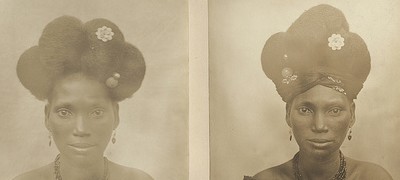Sandra
The context for a blog series about hair came about following an outreach workshop delivered at The National Archives for Year 10 pupils from Acton High School. This particular group wanted something different from the national curriculum; they wanted to explore Caribbean and African collections to creatively inspire individual reinterpretations. Armed with the task of selecting material that would hopefully engage and stimulate discussions, I worked with archivist Etienne Joseph, (a previous recipient of The National Archives’ Education bursary scheme) to develop and facilitate a learning workshop. Taking the concept of haiku style poetry, the group produced a series of responses using iPads and shadow puppets to record their pieces online.
For the second half of the workshop I selected photographic records depicting various Ghanaian hairstyles worn in the 1900’s when Ghana was still under British colonial rule. One of the records was a portraiture featuring a woman from the ‘Gold Coast’ with a particularly striking hairstyle. A group discussion began to shape around themes such as identity, ‘natural’ beauty, adornment and gender. That discussion was our starting point for Hair.
This series is by no means a literal translation of hair related documents or an attempt at the history of hairstyles. From our initial research it is clear that hair is being re-imagined through art, music, exhibition, publications and blogs. I’m sure you can’t fail to notice the fast growing trend of moustaches and beards – a look that once upon a time only your favourite schoolteacher could get away with. For the sartorial man about town (this look is particularly fierce east of the London Overground) it may be a bit of a renaissance thing, hair worn in this way could be seen as a symbol of male masculinity. Dreadlocks, wigs and coiffures also get a mention in our series: will it be the return of ‘big hair’?
Working with Etienne I set a creative brief to use a widely conceptual theme, and interpret various sub-themes within it using archival material. Not an easy feat I must confess and Etienne can tell his own story. But you’ll be pleased to know after months of combing through our records and researching all manner of glorious historical hairstyles from collections around the globe, he still has some hair left. We actually came across a few locks of hair in the archives, but more on those snippets later.
From an outreach perspective, we hope you’ll continue to stay with us throughout the series, comment, share and enlighten us with new debates and archival collections related to historical readings of hair. From resistance and rebellion, sub-culture through to popular culture, our intention is that this series inspires you to explore our records further. There’s a whole lot more research we wanted to include in the series, some of it could have easily been in the shape of on-site workshops, pop-ups and exhibitions – let’s see what creative ideas come to life as a result of the series! To see a selection of additional material not featured in the series, please see our Pinterest board dedicated of course to the theme of hair.
Etienne
One year on, and unable to shake the memory of the enthusiasm generated by the combination of hair and history, I’ve dedicated a series of blog posts to it! Expanding beyond the Colonial Office remit of the original workshop, I’ve made it my business to scour the strong rooms for hair-related records across The National Archives’ collections and the results have been fascinating. The fact that I’ve learnt about the legalization of cannabis cultivation by King Henry VIII, the process of creating a photo-micrograph and how to archive human hair should provide an indication of just how wide-ranging The National Archives’ records are in this regard.
Join me as I delve into a select few of our country’s hair-stories and prepare to be amazed by the folicularly-inspired legalities, innovations and social histories hidden in the archives.


Have you done any research on hair in Scotland, and if so could you kindly contact by e mail?